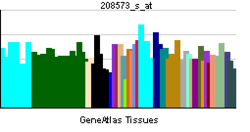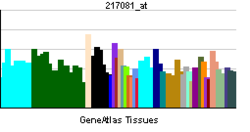- OR2H2
-
Olfactory receptor, family 2, subfamily H, member 2 Identifiers Symbols OR2H2; FAT11; MGC126732; MGC138381; OLFR2; OLFR42B; OR2H3; dJ271M21.2; hs6M1-12 External IDs OMIM: 600578 MGI: 2177473 HomoloGene: 68546 GeneCards: OR2H2 Gene Gene Ontology Molecular function • receptor activity
• olfactory receptor activityCellular component • plasma membrane
• integral to membraneBiological process • defense response
• sensory perception of smell
• mating
• response to stimulusSources: Amigo / QuickGO RNA expression pattern 

More reference expression data Orthologs Species Human Mouse Entrez 7932 258469 Ensembl ENSG00000204657 ENSMUSG00000056600 UniProt O95918 n/a RefSeq (mRNA) NM_007160 NM_146477.2 RefSeq (protein) NP_009091 NP_666688.2 Location (UCSC) Chr 6:
29.66 – 29.66 MbChr 17:
37.22 – 37.22 MbPubMed search [1] [2] Olfactory receptor 2H2 is a protein that in humans is encoded by the OR2H2 gene.[1]
Olfactory receptors interact with odorant molecules in the nose, to initiate a neuronal response that triggers the perception of a smell. The olfactory receptor proteins are members of a large family of G-protein-coupled receptors (GPCR) arising from single coding-exon genes. Olfactory receptors share a 7-transmembrane domain structure with many neurotransmitter and hormone receptors and are responsible for the recognition and G protein-mediated transduction of odorant signals. The olfactory receptor gene family is the largest in the genome. The nomenclature assigned to the olfactory receptor genes and proteins for this organism is independent of other organisms.[1]
Contents
See also
References
Further reading
- Fan W, Liu YC, Parimoo S, Weissman SM (1995). "Olfactory receptor-like genes are located in the human major histocompatibility complex.". Genomics 27 (1): 119–23. doi:10.1006/geno.1995.1013. PMID 7665158.
- Fan W, Cai W, Parimoo S, et al. (1996). "Identification of seven new human MHC class I region genes around the HLA-F locus.". Immunogenetics 44 (2): 97–103. doi:10.1007/BF02660056. PMID 8662070.
- Eklund AC, Belchak MM, Lapidos K, et al. (2000). "Polymorphisms in the HLA-linked olfactory receptor genes in the Hutterites.". Hum. Immunol. 61 (7): 711–7. doi:10.1016/S0198-8859(00)00132-4. PMID 10880742.
- Younger RM, Amadou C, Bethel G, et al. (2001). "Characterization of clustered MHC-linked olfactory receptor genes in human and mouse.". Genome Res. 11 (4): 519–30. doi:10.1101/gr.160301. PMC 311051. PMID 11282967. http://www.pubmedcentral.nih.gov/articlerender.fcgi?tool=pmcentrez&artid=311051.
- Fuchs T, Malecova B, Linhart C, et al. (2003). "DEFOG: a practical scheme for deciphering families of genes.". Genomics 80 (3): 295–302. doi:10.1006/geno.2002.6830. PMID 12213199.
- Strausberg RL, Feingold EA, Grouse LH, et al. (2003). "Generation and initial analysis of more than 15,000 full-length human and mouse cDNA sequences.". Proc. Natl. Acad. Sci. U.S.A. 99 (26): 16899–903. doi:10.1073/pnas.242603899. PMC 139241. PMID 12477932. http://www.pubmedcentral.nih.gov/articlerender.fcgi?tool=pmcentrez&artid=139241.
- Volz A, Ehlers A, Younger R, et al. (2003). "Complex transcription and splicing of odorant receptor genes.". J. Biol. Chem. 278 (22): 19691–701. doi:10.1074/jbc.M212424200. PMID 12637542.
- Mungall AJ, Palmer SA, Sims SK, et al. (2003). "The DNA sequence and analysis of human chromosome 6.". Nature 425 (6960): 805–11. doi:10.1038/nature02055. PMID 14574404.
- Malnic B, Godfrey PA, Buck LB (2004). "The human olfactory receptor gene family.". Proc. Natl. Acad. Sci. U.S.A. 101 (8): 2584–9. doi:10.1073/pnas.0307882100. PMC 356993. PMID 14983052. http://www.pubmedcentral.nih.gov/articlerender.fcgi?tool=pmcentrez&artid=356993.
- Gerhard DS, Wagner L, Feingold EA, et al. (2004). "The status, quality, and expansion of the NIH full-length cDNA project: the Mammalian Gene Collection (MGC).". Genome Res. 14 (10B): 2121–7. doi:10.1101/gr.2596504. PMC 528928. PMID 15489334. http://www.pubmedcentral.nih.gov/articlerender.fcgi?tool=pmcentrez&artid=528928.
- Santos PS, Kellermann T, Uchanska-Ziegler B, et al. (2010). "Genomic architecture of MHC-linked odorant receptor gene repertoires among 16 vertebrate species.". Immunogenetics. 62 (9): 569–84. doi:10.1007/s00251-010-0468-6. PMID 20680261.
External links
This article incorporates text from the United States National Library of Medicine, which is in the public domain.
Class II
(tetrapod specific receptors)Family 1Family 2A1 · A2 · A4 · A5 · A7 · A12 · A14 · A25 · A42 · AE1 · AG1 · AG2 · AJ1 · AK2 · AP1 · AT4 · B2 · B3 · B6 · B8 · B11 · C1 · C3 · D2 · D3 · F1 · F2 · G2 · G3 · G6 · H1 · H2 · J1 · J2 · J3 · K2 · L2 · L3 · L5 · L8 · L13 · M2 · M3 · M4 · M5 · M7 · S2 · T1 · T2 · T3 · T4 · T5 · T6 · T8 · T10 · T11 · T12 · T27 · T29 · T33 · T34 · T35 · V1 · V2 · W1 · W3 · W5 · Y1 · Z1
Family 3Family 4Family 5Family 6Family 7Family 8Family 9Family 10Family 11Family 12Family 13Categories:- Human proteins
- Transmembrane receptor stubs
- G protein coupled receptors
Wikimedia Foundation. 2010.
